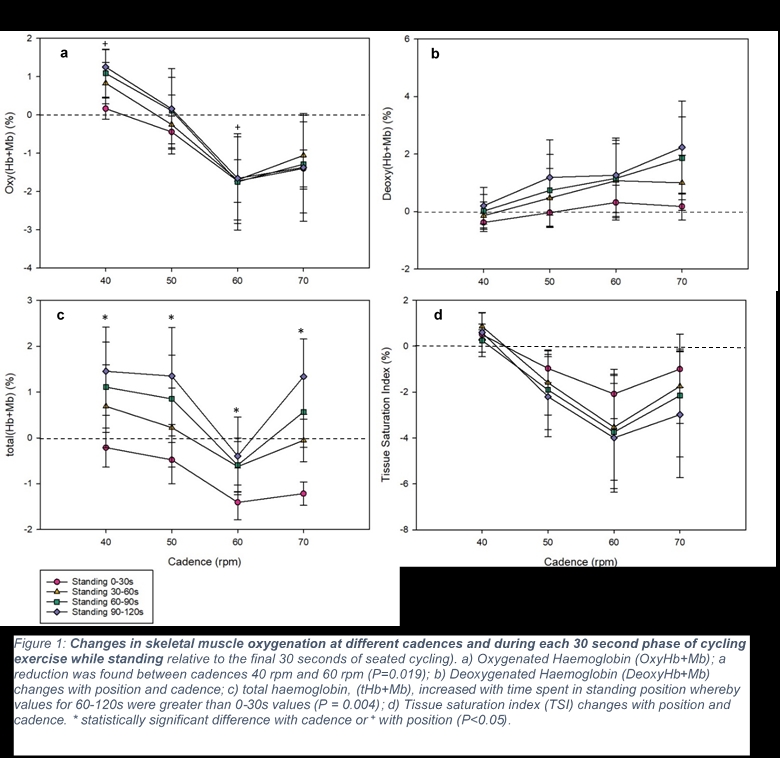Introduction and Aims: The degree of oxygenation in the exercising skeletal muscle may be a factor influencing optimum cycling performance, together with work rate, cadence or position used by the cyclist. Where muscle metabolism is greater, i.e. with increasing work rate or elevated cadence, its oxygenation can decline at a work rate equal to the participant’s ventilatory threshold (Tvent) (1,2). Current literature agrees that where work rate and cadence are fixed, standing while cycling increases metabolism (3,4).The present study considered the effect of standing on skeletal muscle oxygenation, during cycling exercise at different cadences at a submaximal work rate equivalent to 75% Tvent. Methods: Seven healthy human participants, of varying cycling experience, completed a protocol pedalling at 40, 50, 60 and 70 revolutions per minute (rpm) on an electromagnetically braked cycle ergometer. Each cadence was sustained for 5 minutes, subdivided into seated (3 min) followed by standing (2 min) phases, and interspersed with active recovery periods at 19% of Tvent (5). Near infrared spectroscopy (Portamon, Artinis) was used to determine vastus lateralis oxygenation changes with posture and cadence. Cardiopulmonary data were collected via Metasoft computer system (Cortex). A two-way repeated measures ANOVA and where appropriate Bonferroni’s post hoc test were used for analyses. The study was approved by the Research Ethics Committee at King’s College London. Results: Oxygenated haemoglobin was 2.5% lower at 60 rpm compared with 40 rpm (P = 0.019) [Fig. 1a]. Total haemoglobin increased over time during standing cycling, where the 60-120s standing values were 1.3% greater than 0-30s values (P<0.004) [Fig. 1c]. Tissue saturation index was not significantly different between cycling intervals and cadences [Fig. 1d]. All cardiopulmonary variables studied increased with cadence and time spent in standing position [Fig. 2a-d]. Conclusions: Vastus lateralis oxygenation changes between seated and standing were significant for total haemoglobin, where time of standing phase increased, and for oxygenated haemoglobin at 60pm at 75% Tvent. This study provides a basis for further research into the effect of postural changes during cycling on muscle oxygenation. To consolidate these findings, a greater number of participants must be assessed. Further studies may employ electromyography to investigate how a change in muscle activity may be associated with muscle oxygenation in different positions. Key Words: Cycling, Position, Cadence, Near Infrared Spectroscopy, Tissue Saturation Index.
Future Physiology 2020 (Virutal) (2020) Proc Physiol Soc 46, PC0090
Poster Communications: The effects of standing whilst cycling on skeletal muscle oxygenation
Molly Bridge1
1 Kings College London, London, United Kingdom
View other abstracts by:
Where applicable, experiments conform with Society ethical requirements.


